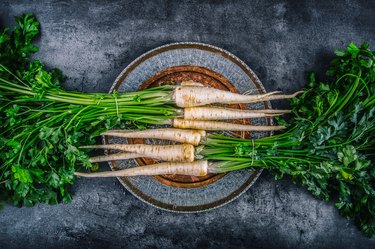
Both parsnips and parsley root are winter root vegetables with edible parts that develop underground. And although they're both members of the Umbelliferae family, which also includes carrots, celery, parsley, chervil, fennel and celeriac, they taste quite different.
However, both are equally good sources of fiber and vitamin C. Here's what you need to know about parsnips and parsley root, as well as how to use each of them for maximum nutritional benefit.
Video of the Day
Video of the Day
What Are Parsnips?
The humble parsnip looks similar to the carrot, except instead of being orange, it's light yellow or off-white. Parsnips have a delicate, sweet flavor and an aroma reminiscent of celery. Smooth, light and starchy in texture, they can replace potatoes in recipes.
Although you can enjoy parsnips year round, their optimal season is from autumn through spring. Parsnips take on sweetness by remaining in the ground and reach maximum sweetness after a frost.
When shopping for this vegetable, look for parsnips that are firm and dry. Then, once back at home, you can store them in the refrigerator for up to three weeks.
Parsnips Nutrition Information
One medium parsnip has:
- 70 calories
- 0 grams fat
- 17 grams carbohydrates
- 1 gram protein
How to Use Parsnips
The flavor of parsnips is so sweet that in Europe this vegetable was once used to sweeten cakes and jams. Parsnips aren't usually served raw, but a peeled, grated parsnip is mild enough to add to a salad, according to Vegetarians in Paradise.
You can also add peeled slices of parsnips to a wide variety of soups or stews. Try boiling, stewing, sautéing or roasting parsnips on their own or with other vegetables for a healthful, tasty side dish.
What Is Parsley Root?
The parsley root is slightly more slender than the parsnip. Like the parsnip, the parsley root is a pale color and similar to the carrot in appearance.
Steve Albert, a California nurseryman and author of the Harvest to Table website, describes parsley root's taste as a combination of "celeraic and carrot with hints of celery, turnip and parsley leaf."
Parsley root is also sometimes called Hamburg parsley or Dutch parsley. The leaves of the parsley root are broader than those on regular parsley, and can be used to provide flavoring to foods.
Parsley Root Nutrition Information
A 3.5-ounce serving of parsley root contains:
- 55 calories
- 0.6 grams fat
- 12 grams carbohydrates
- 2 grams protein
How to Use Parsley Root
Adding parsley root slices to stews and soups or mixed vegetables will intensify these dishes with a distinct aroma. Try adding a small amount of partially boiled parsley root to boiled potatoes, then mash together. Foods whose flavors are particularly enhanced by parsley root include:
- Cabbage
- Shallots
- Sweet potatoes
- Beets
- Other root vegetables
You can even turn parsley root into a type of seasoning by drying it on a shallow tray in an oven at low heat. After the parsley root cools, store it in a tightly covered jar in a dark place.